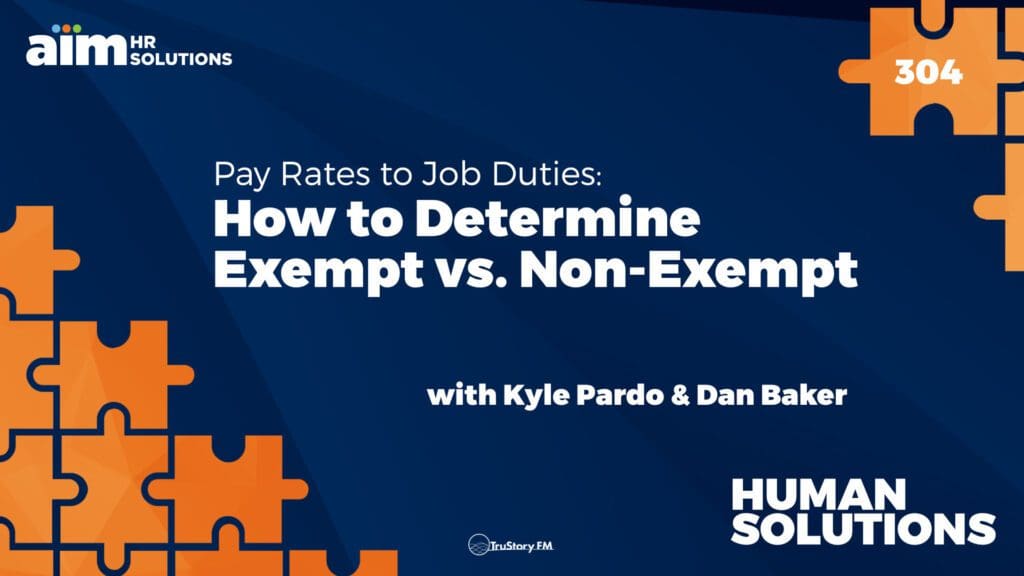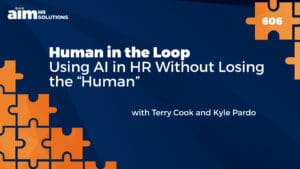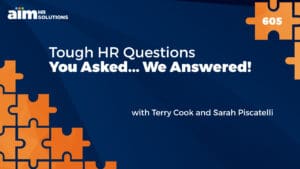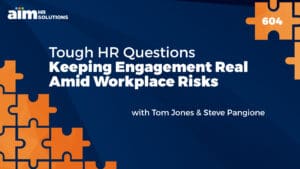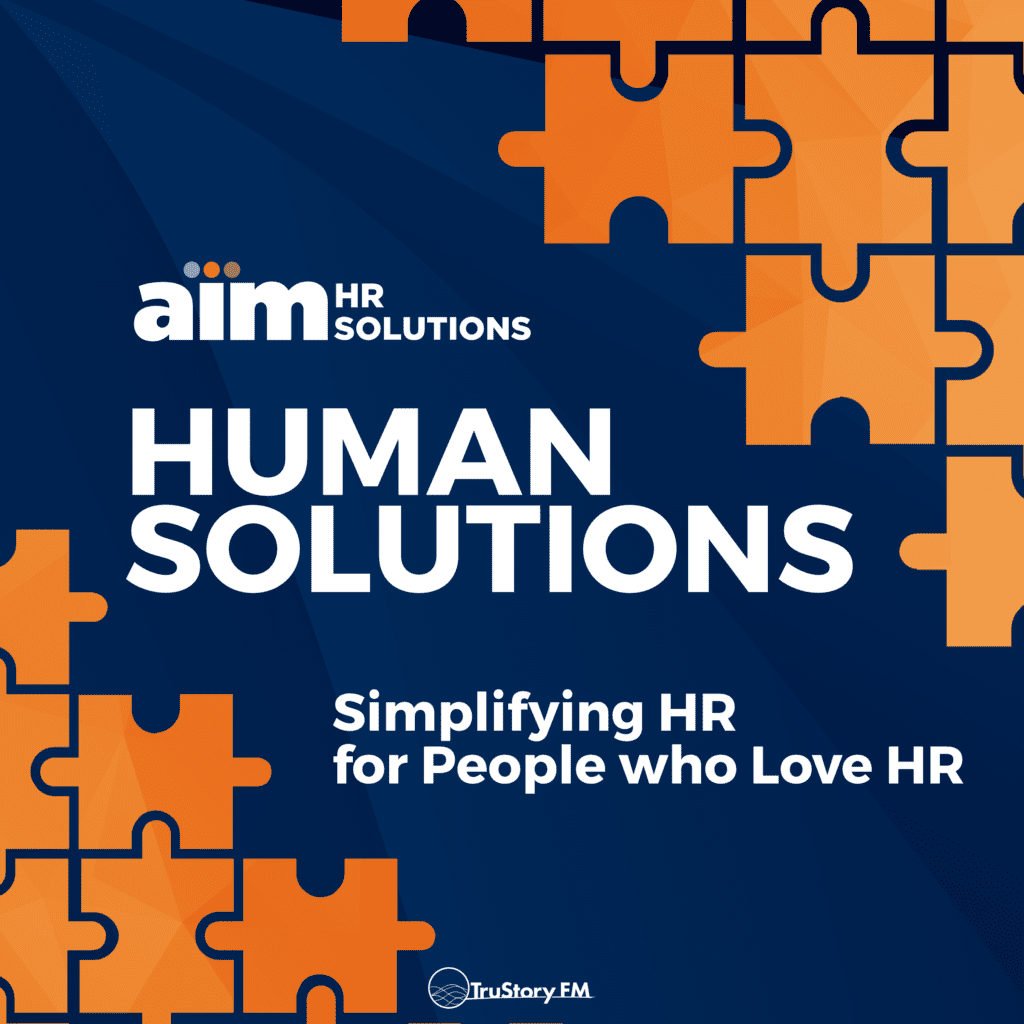Are you confident that your employees are classified correctly as exempt or non-exempt? The answer may not be as straightforward as you think. In this episode of Human Solutions, HR experts Dan Baker and Kyle Pardo from AIM HR Solutions join Pete Wright to explore the ins and outs of exempt vs non-exempt classification.
From the different types of exemptions to common mistakes in classification, Dan and Kyle break down the factors that determine an employee’s exempt or non-exempt status. They also dive into the specifics of calculating overtime pay for non-exempt employees and share tips for maintaining compliance, including the risks involved and the importance of record-keeping.
This episode is a must-listen for any business owner or HR professional who wants to avoid costly misclassification lawsuits and stay compliant with FLSA regulations. Tune in now and get the answers you need to ensure your employees are classified correctly!
Links & Notes
Episode Transcript
Pete Wright:
Welcome to Human Solutions. Simplifying HR for people who love HR. From AIM HR Solutions on True Story FM, I’m Pete Wright, and today we’re talking all about classification. Oh, yes. This is the sexiest topic in all of HR. I’m very excited to talk about it because I’ll bet some of you out there listening aren’t entirely sure if all of your employees are classified correctly as exempt or non-exempt. The answer is not as straightforward as you think. Today, we’ve got HR experts, Stan Baker and Kyle Pardo, from AIM HR Solutions here to talk to me and educate me, and by educating me, educate you on the ins and outs of exempt versus non-exempt classification.
Dan Baker, Kyle Pardo, welcome back to the show. I’m trying to wrap my head around some sort of line of comedy, or jokes, or sexiness to make exemption really pop. And so, I’m counting on you both to help me do that. What can we do to make exemption really pop?
Dan Baker:
Well, that’s a tough one, Pete. We’re going to do our best, but with this stuff, it’s important to pay attention to the details, for sure. We’ll try to weave in as much humorous as possible, but it’s quite the challenge you’ve given us.
Kyle Pardo:
If you get us going, we could probably talk about it for a while too, Pete. So, don’t put it past Dan and I.
Pete Wright:
Well, let’s go ahead and start. For those who are maybe not as fluent in the language of exemptions, why don’t you kick us off with the bare basics? What is exempt versus non-exempt classification, and what are the implications behind decisions we make on how we classify employees? Dan, you want to start?
Dan Baker:
Absolutely. Thank you, Pete. So, let’s start off with what is the FLSA. So, that’s the Fair Labor Standards Act, and that sets the standards for employers with respect to minimum wage from a federal perspective, which as we all know, is $7.25, and that dates back to July of 2009. Obviously, the federal government is quite a bit behind the time. The minimum in Massachusetts, of course, is $15.00 an hour, and many, many states, including some municipalities, have raised their own minimum wage. So, that’s really what we need to pay attention to. And throughout everything we’ll be talking about today, we always have to be aware of not just what’s happening at the federal government with respect to the failure of the Standards Act but also what’s happening at your state levels, and particularly for employers who are multi-state employers, it’s critically important.
But getting back to the FLSA, what we’re looking at here is the minimum wages overtime pay, when that’s required, over 40 in a week in the case of the legislation. Also record keeping, what type of records need to be kept, as well as provisions for child labor. Those are the four main categories. When you talk about what is exempt and what is non-exempt, I would advise employers when they think about this question to start with the notion of all employees are non-exempt, meaning they are covered by the Fair Labor Standards Act. Then from there, when we’re looking at exemptions, we have to look at the specific rules and pay very, very close attention to the duties of what someone is doing. Not just the job titles, but what are those jobs actually doing? We can walk through some examples of what the tests are for exemption and give some practical examples of what they might be.
Kyle Pardo:
I’ll just add a little bit to that. I have a colleague who always asks me, “Which one is it? Is it exempt that you get overtime, is it non, what am I exempt from?”
Pete Wright:
I was going to say exactly those words.
Kyle Pardo:
Oh, yeah.
Pete Wright:
What am I exempt from?
Kyle Pardo:
If you’re exempt, you’re exempt from overtime, meaning you don’t get overtime. If you are a salaried employee, you can work 40, 50 hours a week and you don’t get overtime, you’re not eligible for it, you’re exempt. That’s the easiest way to think about it.
Pete Wright:
Exempt from overtime, and yet, Dan, you just said, start with the assumption that all your employees are non-exempt.
Dan Baker:
Correct.
Pete Wright:
Did I hear that right?
Dan Baker:
Yes.
Kyle Pardo:
Yes.
Dan Baker:
What we’re always talking about when it comes to these questions is making sure we stay on side with respect to the law. So, thinking about it from a practical perspective as an owner or management of a company, one of the things you’re always concerned about in addition to staying on side with respect to the rules, also risk mitigation. You don’t want to set yourself up for potential legal troubles when it comes to exempt or non-exempt. And so, when we think about that, there are three things that we think about when we think about what is exempt, what does that mean?
Well, there are three tests, the first of which is salary level. That means that there’s a certain amount of money you must pay each and every single week, that salary level currently is $684 a week. That’s established by FLSA. Again, it’s been a while since that’s been changed, but that’s what the number is, $684 a week. That’s the minimum must be paid. The second-
Pete Wright:
So, once you’ve gone over that minimum, that means what?
Dan Baker:
Well, that’s the minimum you need to pay, but of course, and in many jobs that are exempt are paying much, much more than that. But $684 establishes the minimum. So, you can’t pay 680 a week and be considered to be exempt. It’s 684.
Pete Wright:
Okay. 684.
Dan Baker:
684.
Pete Wright:
Got it. Very precise. Okay. What is the second test?
Dan Baker:
The second test is a salary basis. That means you can’t be paid on an hourly basis. In order to be considered exempt, you must be paid on a salary basis, an amount that’s established and consistent from week to week. Finally, the third test is the duties test. The first two are relatively easy. The duties test is a lot more complicated. But when you’re looking at the duties test, you’re really looking at the main or most important duties that that employee performs. And the fact is to be considered there, and they’re not limited, this is an exhaustive list. But for example, what are the relative importance of those duties? The amount of time that the person spends performing those duties. They’re relative freedom or not from supervision, and the relationship between the employee’s salary and the wages paid to other employees for the same non-exempt work. And generally, employees who spend 50% of their time performing exempt work will generally satisfy the primary duty requirements.
Kyle Pardo:
So Pete, I want to go back to a couple of things that Dan said that again, I’m going to share some feedback that I get from colleagues who say, “Help me understand this. What does that mean?” And the first point that Dan made I think is really important, is to assume that your employees are non-exempt. So what he’s saying, err on the side of caution. Assume you have to pay overtime to everybody and then go through these tests to make a decision of whether maybe you do have some employees who are exempt from that overtime that you don’t have to pay it. But if you’re ever in doubt, if you’re ever going back and forth, and you’re like, “I don’t really know if this person is exempt or not?” Err on the side of caution and make them non-exempt, pay them overtime and you’ll be on the safer side of things. So that’s the first one.
The second one is Dan said is that there’s these three tests. There’s the salary threshold test that you have to make a certain amount, you have to be paid on a salaried basis, and you have to pass a duties test. You have to pass all three of those tests. So just because I pay you $80,000, I’m paying you a really healthy salary, it’s above that salary threshold. I pay you the same amount every two weeks, when you get your paycheck, it’s a salary that you’re going to get in your paycheck. But the duties that you’re doing, you’re doing a repetitive job or something like that. You may not pass that portion of the test and if you don’t pass that, you could be a non-exempt employee. So I may still have to pay you overtime, even though I’m already paying you a healthy salary. So it’s really important to know you have to pass all three of those.
Pete Wright:
And when it comes to duties, are there any super easy checklisty items that might tell you, okay, this person, for example, their duty is they also manage a team of 10, right. So now, does anything in the overall hierarchy of the organization, depending on where you fall in the org chart, can that help you determine exempt versus not exempt?
Kyle Pardo:
It can’t really be that easy, Pete. It’s got to be more complicated than that.
Pete Wright:
Well, I’m trying. Throw me a bone.
Kyle Pardo:
Dan might say something else. I’m going to say no, that it’s not that cut and dry and I’ll tell you why? Is because part of the tests are things like, do you make decisions on matters of significance?
Pete Wright:
What does that even mean, how do you know?
Kyle Pardo:
So what does that mean? Yes. And so you would need to figure out what that means, there are definitions around it. Document it, make sure it’s in the job description. So if you’re our office manager and you decide how many pens we’re going to buy, and you’re going to buy a new paper for our printer, and you’re going to order the lunch for our company meeting, and you’re going to put that on the company credit card, are those decisions on matters of significance? And the courts on that will probably say no. Okay. But if you’re deciding to buy our-
Pete Wright:
I immediately thought you’re talking about the company credit card, that seems like a matter of significance.
Kyle Pardo:
Yes.
Pete Wright:
So you have suddenly fiduciary responsibility at some level for the organization.
Kyle Pardo:
Yeah. So it has to be something more. It has to be something like you’re buying the new $10,000 photocopier, or you’re engaging in our new rental of our new office space, really things that are significant. So there are definitions, but it’s that type of thought process that can be challenging for employers.
Pete Wright:
Wow. Okay. Well, I don’t want to put the cart before the horse here Dan, but I’m hoping at some point we can transition to where some of these common mistakes are in classifications and how particularly under FLSA, your organization can get bit by making tough decisions.
Dan Baker:
Yeah. Pete, and I would say too, you mentioned the checklist. I would advise employers to go to flsa.gov. The website is very, very good, very easy to follow. Not a lot of legal [inaudible 00:11:31], it’s expressed in common regular English terms. Easy to follow because it is quite complicated and Kyle was giving some good examples, but there are specific exemptions. So there are about six exemptions that you can follow. And I’ll just name them off, executive, administrative, professional, outside sales, certain computer related jobs, as well as there’s also an exemption for highly compensated employees. But we don’t have the time today to get into all of the details of those. But know that there are those six exemptions, and I would reiterate that we really do need to focus on what someone is doing and not necessarily even what they’re called. So titles don’t mean anything in FLSA, right.
So don’t think just because you call someone a manager as an example, that you can call them exempt, that’s not necessarily true. And I’ve seen this working with clients will have a position that is a lead, and they’re leading the work of maybe a group of employees. But they’re not necessarily responsible for performance management of those employees or a disciplinary action or hiring. So they don’t have true management responsibilities. And even though they provide work direction, typically they would not be exempt, so there are cautions. Someone once said to me that FLSA is a field of minefields, you need to be careful because a lot of things that can trip you up.
Pete Wright:
Does shift work matter? And I’m asking because when you apply for a job and they tell you, okay, you’re going to work shifts. Maybe you’re managing a team of people, but you’re also managing a shift, say you’re in retail or quick service food, whatever that case may be. I can make the case that that manager would be a prime among peers, but would be otherwise non-exempt. But say you go to work and you’re becoming an HR manager and you’re not working a shift, you’re expected to just be there all the time. Is there any qualification in that checklist for accountability according to shift?
Dan Baker:
Shift work, in and of itself, I would say no. But if you are regularly managing a team of employees and you’re really involved in managing the business, so you mentioned HR manager. And generally I would say that HR managers, we generally would see them because of what they do typically, the hiring, counseling of management, being involved with those types of decisions, which are, as Kyle pointed out, matters of significance. You could see them as being exempt. But to shift work in of itself, not so much.
Pete Wright:
Okay. So how can you get in trouble by messing up your classification system internally?
Kyle Pardo:
That’s a good question. I’m going to jump in on that one. Is that, if you have been paying an employee exempt, so you’ve not been giving them overtime, you’ve been paying them exempt, and then someone brings a claim against your company, or the Department of Labor does an audit and they look at the job and they say, you know what? This position really should have been non-exempt, you should have been paying overtime for the last six months or a year, whatever it is. The challenge is, as a company, do you have work records? Do you have hours of knowing when that employee worked, to even go back and calculate whether you owe that person any back pay? And in many instances, the answer would be no. A lot of people don’t track the time of their exempt employees. In fact that’s part of the exemptions that you’re not really tracking the hours exempt employees working.
So if you brought a claim against our company and said, I should have been getting paid overtime for the past six months or whatever, the court would probably listen to you if you had your own records and said, I should be owed 10 overtime hours per week. They might take a look at that and say, that’s true, the company owes you that money, plus any penalties or anything else associated with it. So, I go back to Dan’s original point, if you’re not sure, go the other way and make the person non-exempt and pay the overtime if you really want to make sure you have your employees classified correctly.
Pete Wright:
And it sounds like your record keeping has to be on lock?
Dan Baker:
Yes. And under FLSA, the record keeping provision requires that employers, first of all, display the official post to outlining requirements of FLSA, and they must also keep employee time and pay records. Which would include things like their total daily, or weekly straight time earnings, their total overtime earnings if any, for that same time period. And any additions to, or deductions from pay, as well as total wages paid each pay period. So when you mentioned a checklist, that’s a checklist of things that they must do.
Pete Wright:
It sounds like that’s moving us in the direction of making things easier and yet, somehow it’s not easy, this is not easy. So let’s transition into calculating pay, I know there are some considerations around calculating overtime pay and how that’s attributed to employees. What do I need to be thinking about, Dan?
Dan Baker:
It’s really simple, I think. The things you should calculate, if you’re looking at overtime, what’s the way to do it? And we’re going to assume for purposes of this discussion that there’s a single rate of pay. In other words, the job isn’t split, where someone’s doing job A for some percent of the time, that pays a certain rate as job B. I’m going to keep it simple and just assume it’s a single rate, so I’ll say that rate is $15 an hour. So the first thing you need to know is, how many hours did that person work that week, and what’s the regular rate? So they worked 40 hours, $15 an hour, that’s $600. But in this particular week, the employee worked 45 hours, so we already know the regular rate for 40 hours, which is 600. If they then worked overtime time and a half times, the regulator 15 gives you an additional 22.50.
So we know that the regular rate plus the overtime rate gives you a total pay. I think one of the complications comes in when we talk about bonuses. So when we talk about bonus pay, we have to remember this concept of the regular rate. And very simply, if you have a bonus plan for your employees that isn’t purely discretionary, what do I mean by that? It means it’s not a guarantee, it’s not tied to any production or performance, it’s totally out of the goodness and goodwill of the employer that they grant it every year, or they may not print it every year. And it may be different from year to year, but it’s truly, for lack of a better term, a gift, right. There’s no commitment to pay it, there’s no agreement to pay it, it’s totally discretionary. That bonus is not subject to the overtime calculations.
Now, if on the other hand, you have a bonus that is directly tied to making some profit, or some revenue goal, or something like that, that can be calculated, that’s where companies potentially can run into problems. And in those cases where companies need to do, and let’s assume for purposes of the discussion, it’s an annual bonus. Then the company must look back over that year and figure out how much of that bonus is actually earned each pay period right, and calculate overtime based on that. So if everybody worked 40 hours, there was no overtime, there’s no harm, no foul. However, if you had overtime at all in there, you need to recalculate that bonus because you need to pay time and half, you’re basically allocating that bonus as if it were part of the regular pay over the period.
Pete Wright:
You said something though that made me curious about the times we are living in, which is living through the pandemic and covid. And I know we have headlines around how organizations, particularly healthcare organizations, handle the massive overtime compensation for employees that are frontline workers. Is there any consideration in FLSA for things like hazard pay, for lack of a better term right now, working in frontline situations. Or fighting fires on federal protected land, is there anything around those considerations?
Dan Baker:
Just the fact that if someone gets hazard pay and it’s pay in conjunction with difficult job, that becomes part of their regular rate. So again, if overtime becomes a consideration, it needs to be factored in. And keep in mind, this is what we’re talking about here is only particular to non-exempt employees. When you have exempt employees, the bonus will be what the bonus is, right? But for non-exempt employees, you have to treat it as if it were earned over the period.
Pete Wright:
Over the whole period.
Dan Baker:
Yeah.
Pete Wright:
Okay. There are some words in here, words like good faith when it comes to accurate timekeeping and consideration in the employee, employer relationship, that feel a touch fuzzy to me. Can we walk through the process of record keeping, the audits that go along with that and how that impacts the organization?
Kyle Pardo:
Sure. With anything you want to do what’s right, right? Every employer wants to do what’s right, and we understand that this can be challenging and confusing and so a couple of things to keep in mind. When you have employers fill out time sheets or time records, if you’re still doing it on paper, make sure they’re completing them on a weekly basis or a biweekly basis along with your payroll and they’re signing off on it. Most companies probably now have some, either electronic system that they use to capture time. Or a sign in, sign out, sometimes using your fingerprint or a scan, so they’re really pretty official in that sense. But having accurate time records and having them available in case any other question about your pay came up, is really important.
The other one that I would suggest is making sure you have a good system of identifying how you came up to the decision of whether somebody was exempt or non-exempt.So having job descriptions that clearly identify what somebody does, and as Dan mentioned there, there’s a great website through the Department of Labor. You can go on there, it’ll ask you a series of questions about the job and the responsibilities and whether it makes decisions on matters of significance and things like that. And you can go through this little questionnaire, the answer is somewhere between five and 10 questions. And it will come up with a summary at the end that says, based on the information you provided, this position is likely exempt or non-exempt.
And in an HR role, I would probably go through that process. I would print out that little summary and I’d attach it to my job descriptions. So if the Department of Labor ever came in and audited, I can show that I did the best I could, I answered the questions, I answered them really taking a look at what the position included. And well, the Department of Labor might come up with a different decision than I came up with, it wasn’t that I ignored it in my organization, but that I really tried to do the best I could with it.
Dan Baker:
Right, you acted in good faith.
Pete Wright:
There we are. Okay. So I know in our fictitious manufacturing organization, we’re growing the team and we have a new rank, and that is the rank of sales. We have some that are organizational sales. They work inside of our organization, they just sit in the office and hit the phones and the computers, but we also have some field sales people. Now, I know there is some complication around handling sales in this conversation around exception, I don’t know what it is.
Kyle Pardo:
So outside sales people are exempt. So typically that would mean somebody who’s outside the company, they’re out on the road, they’re driving to customers, bringing their products with them and selling them outside the company.
Pete Wright:
Pharmaceutical sales.
Kyle Pardo:
Exactly.
Pete Wright:
Lumber sales.
Kyle Pardo:
Right, right. They’re on the road, yeah. Inside sales is non-exempt. They’re eligible for overtime. So they’re sitting at your desk inside your company, making phone calls from inside the company, selling whatever it is, and those positions are non-exempt. Now, where it gets a little bit fuzzy is that some of these strategies have changed during covid, people weren’t able to go out to companies and bring pharmaceuticals or eyeglasses or whatever it is that they were selling. They weren’t able to bring those out. And so they might have set up a Zoom call or something like that, to show the product online. And so it moved into a different realm of whether it was inside or outside. And that’s where I think it can be confusing for companies.
Pete Wright:
So what do you do?
Dan Baker:
Well, hopefully you would imagine that those roles that used to be outside the company, now that we’re thankfully getting past covid, those roles are probably transitioning back out again, but I would caution companies. Again, if someone is selling inside the company, I would, as a first thought, think of them as not exempt. Unless you can exempt them under, let’s say the administrative exemption classification, which would be possible but again, it’s going to depend on the job duties and going through that FLSA advisor that’s on the Department of Labor’s website, which is again, very, very helpful, will help them to answer that question.
Pete Wright:
I’m sure, as you said` Kyle, you guys could probably talk about this all day. I feel like we’ve hit a lot of the big points, but Monday morning, 8:00 AM day one, can you each give me the first thing that you would do to either build or review your exempt policy and make sure you’re steering the ship in the right direction as an HR pro, Dan?
Dan Baker:
Yeah. I mentioned risk mitigation, if I were new to a company, what would be the first thing on my list? Would be to look at the jobs that were exempt that I had that were highly populated jobs, particularly if they were lower level in the organizations. And a lot of people, and they’re doing something that I thought might be a non-exempt job, they’re classified as exempt, and I’ve got 30 people doing that. that’s the very first thing I would look at.
Pete Wright:
All right. Kyle, Monday morning?
Kyle Pardo:
Where I would start, I’d give you a couple of job titles, and these are the ones that get people into trouble. I would take a look at titles like customer service, office manager and supervisor or lead that Dan mentioned, to really take a look at what those people do. Because those are the ones that they end up on that borderline and people really aren’t sure which way to go with them.
Pete Wright:
Well, it sounds to me like Monday morning, I’m going to bring up the FLSA advisor and start entering some of those titles in there and making sure that I have my ship in order. Dan Baker and Kyle Pardo, thank you so much for this exemptions 101 tutorial today. You are the voices of reason and calm in a rough seat, thank you.
Dan Baker:
Thank you, Pete.
Kyle Pardo:
Thank you.
Pete Wright:
Thank you everyone for downloading and listening to this show. You’ll find all the notes that we’ve been talking about. You’ll find these great links, including the link to the FLSA advisor in the show notes. Just swipe up in your podcast app or visit us on the website to learn more. On behalf of Dan Baker and Kyle Pardo, I’m Pete Wright. And we’ll see you next week, right here on Human Solutions, simplifying HR. For people who love HR.







